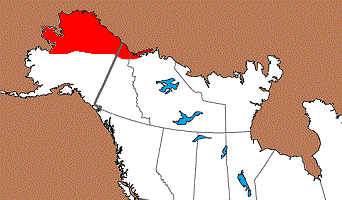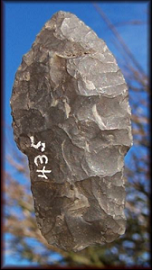Name Details:
Named By:
Named For:
Purpose of point
Date Identified:
Type Site:
Repeating / Thrusting Lance
Cluster:
Commonly Utilized Material:
Date:
Cultural Period:
3,000 - 200 B.P.
Norton Tradition
Yupik and Inupiat Eskimo Cultures
Glacial Period:
Culture:
Outline is Representative of Common Size and Shape:
Description of Physical Characteristics and Flaking Pattern:
This is a medium to large lanceolate stemmed
point with an elliptical cross section. The blade is broad and
excurvate commonly curving back in towards the shoulders. The
shoulder are primarily at an upward angle, but may vary to almost
horizontal. The stem ranges from straight to slightly contracting
with a base that varies from straight to slightly convex or concave.
This point has a random flaking pattern.
Size Measurements: Data needed
Distribution:
Distribution Comments:
This point is primarily found in the Artic
regions of Alaska and into Canada and into the North Slope / Brooks
Range.

Related / Associated Points: \
Additional Comments:
Joel Castanza (Alaska
Artifacts) notes:
A hunter normally paddles rapidly alongside of the Walrus, Bear or other
large game grasps the lance near the butt, as he would a dagger, and stabs the animal with quick multiple
thrust. This spear is called ka'pun, which in the Point Barrow dialect
exactly corresponds to the Greenlandic word kaput, which is applied to the
long-bladed spear or long knife used for dispatching a harpooned seal. The word ka'pun means simply "an instrument for stabbing." Lance shafts are normally 6 feet 2 inches long, and tapers from a
diameter of 0.8 inch about the middle to about one inch at each end. The tip
is cleft to receive the tang of the head, and shouldered to keep the
whipping from slipping off.
Other points in this Cluster:
Point Validity: Valid Type
This point is named based on the purpose of the
point and has many professional references. This is considered a valid
type.
.
Age Details:
References: (See Reference Page, Entry Number):
23, W21
Repeating / Thrusting Lance






